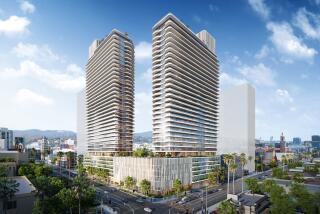Capitol Records Tower Endures as the Hollywood Golden Oldie
- Share via
One of the most enduring myths of Hollywood architecture is that the Capitol Records Tower is meant to look like a stack of records, topped by a needle.
Like all good myths, it has some element of truth but is not necessarily factual. Both the architect and the owner have always claimed that the first round office building in America was merely meant to be noticeable, efficient and futuristic. It certainly fulfills all of those functions.
It is hard to ignore the Capitol Tower, with its beacon on the roof spelling out “H-o-l-l-y-w-o-o-d” in Morse code. Just north of the famous intersection of Hollywood and Vine, it is near enough to the curve of the Hollywood Freeway as it sweeps down the hills to be visible for miles.
Its shape would catch your eye in any case. The circular plan was chosen by architect Welton Becket in 1954 because it represented a scientific paradigm: the largest amount of area enclosed by the smallest amount of wall.
Since then, decorators have found out that it is also a shape that is hard to divide up and furnish. Moreover, it doesn’t take into account the peculiarities of any given site. As a result, the building has become a one-of-a-kind landmark rather than a prototype, a symbol for the jazzy technological optimism of the 1950s.
The innovations don’t stop with the form of the building. It was the first office building in Hollywood to be fully air-conditioned. Its 12-story tower, which appears to float above a concrete base, contains what was once the first high-fidelity recording studio in the world. The “eyelids” that circle the building are metal sunshades that protect the inhabitants from light and heat as the sun tracks around the tower.
Unfortunately, little of that innovation shows up close. The structure of the tower is formed by blue-gray concrete columns and slabs, and the same material covers the bunker-like base. There is little recognition of life on the street, and the materials look rather static and worn. The color makes most of the tower disappear into the shade behind the curve of the sunshades, and the box of the recording studio shares many qualities with the backs of the Hollywood Boulevard theaters that are some of its most immediate neighbors.
The entrance lobby at least provides a moment of high-Hollywood glitz: As the square concrete columns come down, they are transformed into round gold pillars that match the wall of gold records displayed behind the security desk.
Perhaps it is best not to question the Capitol Tower too closely. It is better to think of it as the largest Pop Art sculpture in town, or to use it as a landmark that defines the place and myth of Hollywood. When you look at it too hard, it starts to look a little too much like a real building with real problems, marooned in an expanse of parking lots and worn down by almost four decades of rock ‘n’ roll. It’s a Golden Oldie, scratched and sappy, but still better than most of that stuff they play these days.
More to Read
The biggest entertainment stories
Get our big stories about Hollywood, film, television, music, arts, culture and more right in your inbox as soon as they publish.
You may occasionally receive promotional content from the Los Angeles Times.










